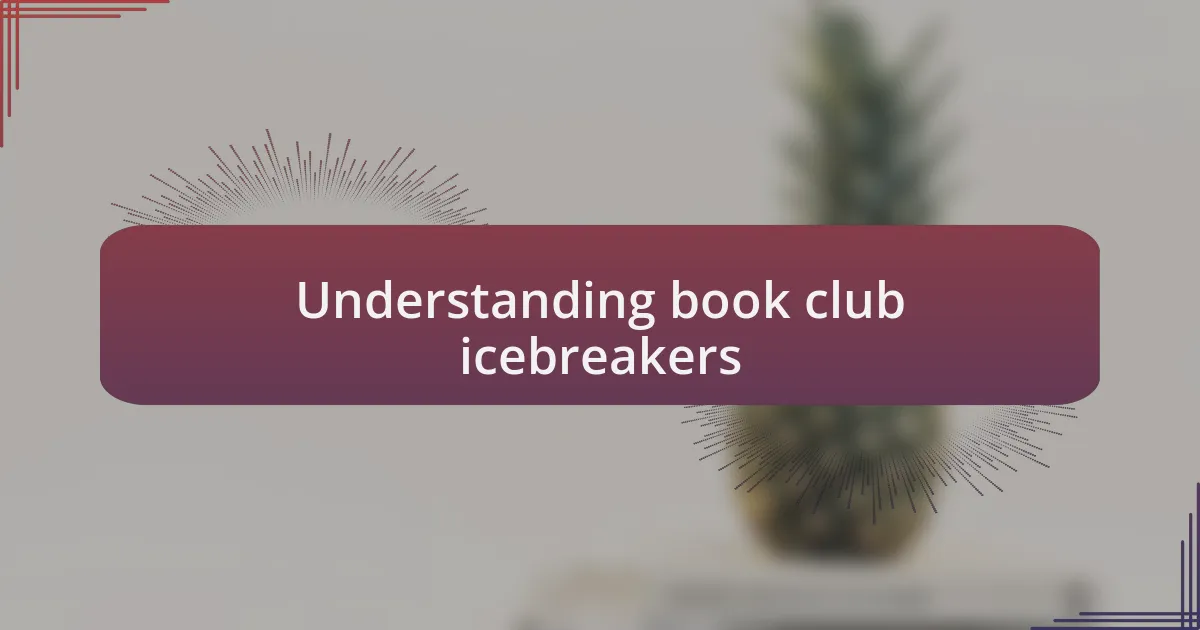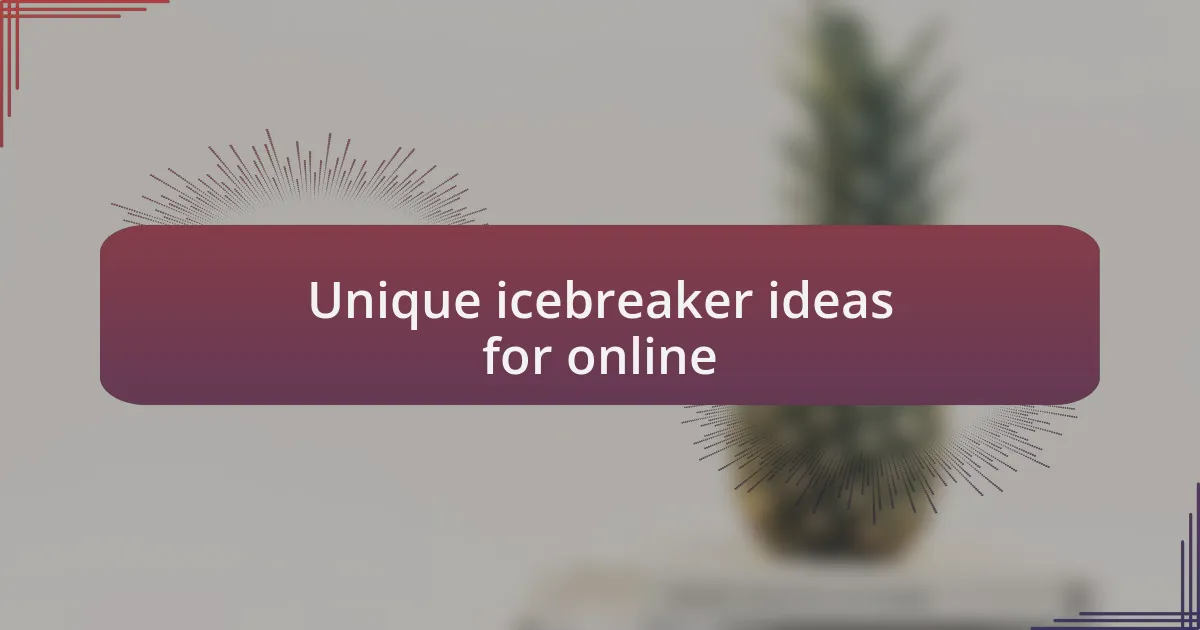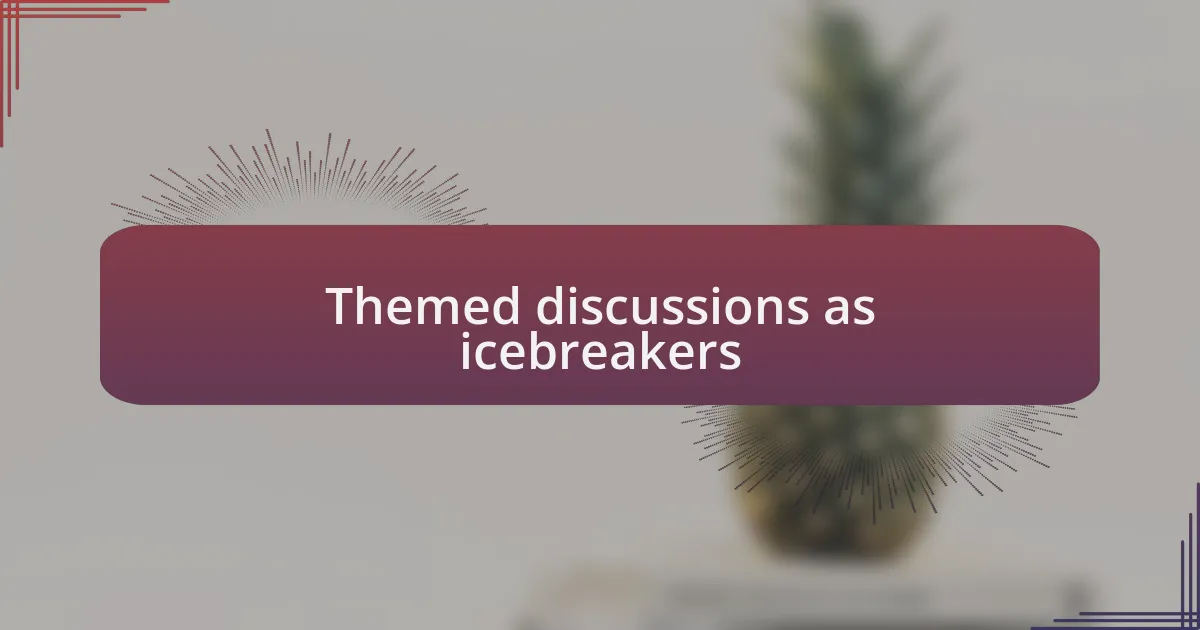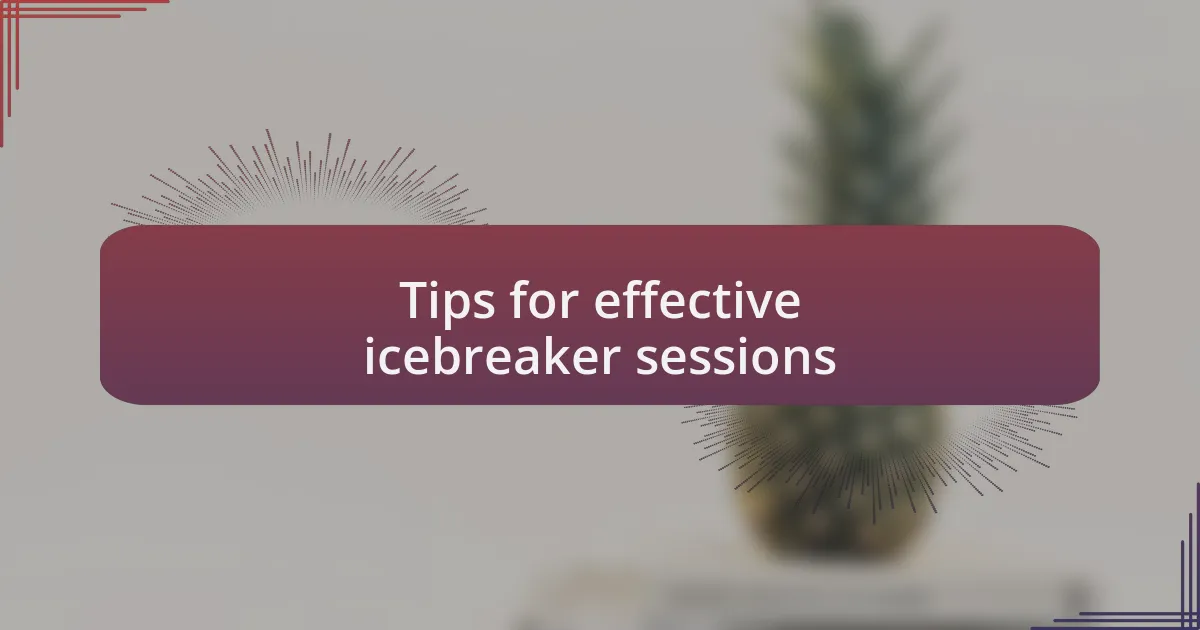Key takeaways:
- Book club icebreakers help foster connections, encourage sharing, and create a welcoming atmosphere for discussions.
- Popular icebreaker activities like “Two Truths and a Lie,” “Book Bingo,” and “Storytelling Circle” promote engagement and reveal personal traits.
- Themed discussions, such as “Books That Changed the World” or “Literary Travel Destinations,” enhance conversation depth and personal connections.
- Effective icebreakers ensure participants feel comfortable, are cohesively linked to the book theme, and are kept brief for impactful sharing.

Understanding book club icebreakers
Book club icebreakers serve as the vital first step in creating a welcoming atmosphere. I’ve often experienced how a well-placed question or activity can uplift the group’s energy, making members feel valued and eager to share. Have you ever noticed how one simple game can ease those initial awkward moments and pave the way for richer discussions?
Understanding why icebreakers are effective is essential. They encourage connections that go beyond just the books; they foster friendships. I recall a time when a member shared a personal connection to a book we read, sparking a heartfelt conversation that continued long after the meeting. This kind of bonding is what I cherish most about these gatherings.
Additionally, icebreakers can be tailored to fit the mood of the group or the theme of the book being discussed. For instance, if the book features strong female protagonists, I might suggest an icebreaker where everyone shares a fictional character they admire. It’s a simple yet powerful way to dive deeper into both the literature and our own lives, creating a richer experience for everyone involved.

Popular icebreaker games for groups
One popular icebreaker game I like to use is called “Two Truths and a Lie.” Each member shares two true statements and one false one about themselves. It’s fascinating to see how well—or poorly—we know each other! I remember a time when someone claimed they had written a bestseller, and we were all left in disbelief when we found out that wasn’t true—it sparked great laughter and even more storytelling.
Another fun activity is “Book Bingo,” where participants bring favorite books and fill out a bingo card with various book-related prompts, like “Read a book by a debut author” or “Enjoyed a book set in another country.” Not only does it spur engagement, but it also serves as a delightful way to explore personal tastes. I’ve found that people often surprise me with the unique books they choose, revealing snippets of their personalities that books alone may not uncover.
Then there’s “Storytelling Circle,” where each member contributes a sentence to create a collaborative story. This simple game has often led to unexpected, hilarious, and heartfelt tales that reflect the dynamics of the group. Sometimes, I wonder if a group can truly bond over a fictional narrative; surprisingly, the answer is yes! It reminds me of how powerful storytelling can be—as it merges our voices, styles, and quirks into something refreshingly original.

Unique icebreaker ideas for online
One icebreaker I’ve tried is “Book Cover Guessing Game.” In this activity, everyone creates a fictional book cover that represents their life or interests, using images cut from magazines or drawn by hand. I was surprised by how open people became when sharing their creations; it revealed so much about their aspirations and creativity. Have you ever wondered how a simple piece of art can spark such profound connections?
Another unique idea is the “Fictional Dinner Party” icebreaker. Here, each member invites three fictional characters—real or from literature—to a dinner party and explains why. I vividly recall someone inviting Sherlock Holmes, Harry Potter, and Katniss Everdeen. Their explanations not only showcased their personality but sparked lively discussions about favorite stories and characters. It was a wonderful reminder of how our fictional companions can shape our understanding of ourselves.
Finally, consider the “Book Soundtrack Challenge.” In this fun twist, participants choose songs that they believe perfectly capture the essence of their favorite book. I remember one member picked “Bohemian Rhapsody” for a classic novel, explaining how its dramatic shifts mirrored the book’s plot twists. It felt incredibly enriching to explore the intersection of music and literature, making me appreciate the depth of both art forms even more.

Themed discussions as icebreakers
Themed discussions can really elevate the icebreaker experience in a book club. I once hosted a session centered around “Books That Changed the World.” Each participant shared a selection and why they felt it resonated with them, stirring not just interest but deep conversations about how literature shapes societal views. It was eye-opening to see how personal experiences intertwine with the ideas presented in influential texts.
Another time, I facilitated an icebreaker called “Literary Travel Destinations,” where each member discussed a book that made them want to visit a specific location. The excitement was palpable as one member described her yearning to travel to the moors from “Wuthering Heights,” reflecting on how the landscape matched her emotional journey within the story. I found it fascinating how a setting could evoke such longing and connection.
Additionally, introducing a theme like “Books with Unforgettable Villains” can ignite passionate debates. In one session, a member passionately defended the moral grayness of a villain from a popular series. As they spoke, I felt a wave of emotions—both nostalgia for the character and admiration for the depth of their argument. It’s moments like these that remind us how literature facilitates not just discourse but also emotional exploration.

Personal stories sharing icebreakers
One of my favorite icebreakers involves sharing a personal story related to a book that impacted us. I remember a time when a member of my book club revealed how “The Alchemist” by Paulo Coelho inspired her to pursue a long-forgotten dream of becoming an artist. As she spoke, I could sense the vulnerability in her voice, and it sparked a heartfelt discussion about how literature can often serve as a catalyst for personal change. Have you ever felt a book calling you to action in your own life?
Another powerful icebreaker is the “Book That Made You Cry” activity. I once experienced a moment of pure connection when a member shared how “The Fault in Our Stars” resonated with her during a tough time in her own life. She talked about the raw emotions she felt while reading it, and I found myself reflecting on the books that have left me in tears. It made me wonder—why do we feel so deeply connected to the characters as if they were part of our own stories?
Lastly, I cherish the “First Book You Loved” icebreaker, which invites vulnerability and nostalgia. During one session, a participant discussed how “Charlotte’s Web” opened her heart to the concept of friendship and loss at a young age. The collective sighs in the room underscored how similar experiences can lead to a profound understanding of one another. It left me pondering—what is it about our first loves in literature that shapes our emotional lives?

Tips for effective icebreaker sessions
Creating an environment where participants feel comfortable sharing is essential for effective icebreaker sessions. I remember one meeting where I decided to start with a light-hearted question, asking everyone to share their guilty pleasure read. The laughter that followed opened the door for deeper conversations, as people felt more relaxed discussing their literary preferences. How often do you find that humor can break down barriers and foster connection?
Another tip is to keep the icebreakers linked to the book theme for cohesion. For instance, one time I introduced a quirky activity where each person had to describe their favorite book using three emojis. It was amusing and surprisingly opened avenues for deeper discussions. Have you noticed how creativity in icebreakers can lead to unexpected revelations and insights about fellow members?
Lastly, timing is key. I’ve learned that keeping icebreaker activities brief yet impactful allows the conversation to flow naturally. For example, during one session, I limited our icebreaker to just five minutes, which encouraged participants to focus on what really mattered to them. Have you ever noticed how a little time pressure can actually sharpen our thoughts and make our shares more purposeful?